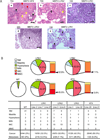Expression of autotaxin and lysophosphatidic acid receptors increases mammary tumorigenesis, invasion, and metastases
- PMID: 19477432
- PMCID: PMC4157573
- DOI: 10.1016/j.ccr.2009.03.027
Expression of autotaxin and lysophosphatidic acid receptors increases mammary tumorigenesis, invasion, and metastases
Erratum in
- Cancer Cell. 2009 Aug 4;16(2):172
Abstract
Lysophosphatidic acid (LPA) acts through high-affinity G protein-coupled receptors to mediate a plethora of physiological and pathological activities associated with tumorigenesis. LPA receptors and autotaxin (ATX/LysoPLD), the primary enzyme producing LPA, are aberrantly expressed in multiple cancer lineages. However, the role of ATX and LPA receptors in the initiation and progression of breast cancer has not been evaluated. We demonstrate that expression of ATX or each edg family LPA receptor in mammary epithelium of transgenic mice is sufficient to induce a high frequency of late-onset, estrogen receptor (ER)-positive, invasive, and metastatic mammary cancer. Thus, ATX and LPA receptors can contribute to the initiation and progression of breast cancer.
Figures







Comment in
-
Mammary tumorigenesis through LPA receptor signaling.Cancer Cell. 2009 Jun 2;15(6):457-9. doi: 10.1016/j.ccr.2009.05.003. Cancer Cell. 2009. PMID: 19477423
References
-
- Aylon Y, Oren M. Living with p53, Dying of p53. Cell. 2007;130:597–600. - PubMed
-
- Balkwill F, Charles KA, Mantovani A. Smoldering and polarized inflammation in the initiation and promotion of malignant disease. Cancer Cell. 2005;7:211–217. - PubMed
-
- Benito M, Parker J, Du Q, Wu J, Xiang D, Perou CM, Marron JS. Adjustment of systematic microarray data biases. Bioinformatics. 2004;20:105–114. - PubMed
-
- Benjamini Y, Hochberg Y. Controlling the false discovery rate: a practical and powerful approach to multiple testing. J R Statist Soc B. 1995;57:289–300.
Publication types
MeSH terms
Substances
Associated data
- Actions
Grants and funding
LinkOut - more resources
Full Text Sources
Other Literature Sources
Molecular Biology Databases
Miscellaneous

